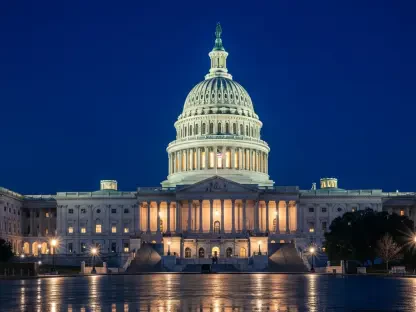Setting the Stage: A Policy Shock to Tech Talent Dynamics
In a bold move that has sent shockwaves through the tech sector, a $100,000 fee for new H-1B visa applications has been introduced, fundamentally altering the landscape for companies reliant on global talent. Announced by the current administration in September, this policy targets a program that has long served as a pipeline for highly skilled foreign workers, particularly in technology hubs like Silicon Valley. With the U.S. tech industry already grappling with a shortage of domestic expertise, this staggering cost increase raises urgent questions about hiring strategies, innovation capacity, and global competitiveness. The fee’s implications extend beyond mere finances, potentially reshaping how firms operate in a market driven by rapid advancements and fierce international rivalry.
This analysis aims to dissect the market trends, data, and projections surrounding this policy shift, providing a comprehensive view of its impact on the tech industry. By examining current hiring challenges, financial burdens, and emerging strategic responses, the discussion seeks to illuminate the broader economic stakes. The purpose is to equip stakeholders with actionable insights into navigating this new reality, ensuring that the sector can adapt while maintaining its pivotal role in driving national growth. What lies ahead for tech innovation under such constraints is a pressing concern that demands thorough exploration.
Diving Deep: Market Trends, Data, and Projections in the Tech Sector
Financial Pressures: The Cost of Talent in a New Era
The introduction of a $100,000 fee for each new H-1B visa application marks a dramatic escalation from previous costs, which typically ranged from under $1,000 to a few thousand dollars. For large tech corporations employing thousands of H-1B workers—such as those with upwards of 12,000 or 5,000 visa holders—the annual financial burden could soar into millions of dollars. This shift threatens to redirect critical budgets away from research and development toward visa expenses, potentially slowing the rollout of cutting-edge technologies in areas like artificial intelligence and cloud computing.
Smaller firms and startups, often operating on razor-thin margins, face an even graver challenge. Many of these entities, which are frequently the crucibles of disruptive innovation, may find the fee prohibitive, forcing them to scale back ambitions or forgo hiring specialized foreign talent altogether. Market data indicates that startups contribute significantly to job creation and technological breakthroughs, and a reduction in their ability to access global expertise could dampen sector-wide dynamism. This financial strain is poised to create a stratified market where only well-capitalized giants can afford to maintain diverse talent pools.
Looking ahead, projections suggest that if the fee remains in place, hiring budgets across the industry could contract by as much as 15-20% over the next two years, based on current employment trends of approximately 730,000 H-1B workers in the U.S. This contraction may lead to a noticeable slowdown in project timelines, especially for initiatives requiring niche skills. The ripple effect could extend to investors, who might view constrained talent access as a risk factor, potentially impacting funding for tech ventures in the near term.
Talent Gaps: A Domestic Shortage Amplified by Policy
A persistent shortage of skilled domestic tech workers underpins the industry’s reliance on H-1B visas, with around 85,000 new visas issued annually to address critical needs. Surveys from recruiting firms reveal that 87% of tech leaders struggle to find qualified candidates for roles in software engineering, data science, and cybersecurity. The median wage for H-1B workers, pegged at $118,000, reflects the high-value nature of these positions, often placing them in the top echelon of U.S. earners, countering narratives of wage suppression.
Compounding this issue is a lack of sufficient investment in STEM education, with funding for science programs at historic lows. This gap in domestic talent development means that even with a push to prioritize American labor, the market cannot quickly pivot to fill specialized roles without foreign expertise. Projections indicate that without significant educational reform, the tech sector could face a deficit of over 200,000 skilled workers by 2027, exacerbating delays in innovation cycles and project execution.
The policy’s impact on talent availability is expected to create a bottleneck in high-growth areas such as machine learning and quantum computing, where global competition is intense. As companies grapple with fewer options to staff critical projects, market analysts anticipate a potential decline in the U.S. share of groundbreaking patents and technologies over the next five years. This trend underscores a disconnect between policy objectives and the structural realities of the tech labor market.
Global Competition: Redirecting Talent and Operations Abroad
One of the most significant market trends emerging from the H-1B fee hike is the potential redirection of global talent to other nations with more favorable immigration frameworks. Countries like Canada and the United Kingdom, offering streamlined visa processes and lower costs, stand to gain as top-tier professionals reconsider their destination of choice. This shift could enhance the tech ecosystems of rival markets, positioning them to challenge U.S. dominance in innovation hubs.
Industry projections suggest that up to 30% of prospective H-1B applicants might opt for alternative countries over the next three years if the fee and associated uncertainties persist. This migration of talent could lead to a measurable loss in U.S. market share for tech-driven economic output, particularly in software and hardware development sectors. Additionally, the alignment of time zones and cultural proximity in regions like Canada makes offshoring an attractive option for firms seeking to bypass domestic constraints.
The competitive landscape is further complicated by the possibility of companies relocating portions of their operations abroad to access talent pools directly. Market analysis indicates a growing interest in establishing satellite offices in tech-friendly nations, with a potential 10% increase in such moves by 2027. This trend risks not only a brain drain but also a reduction in domestic job creation, ironically undermining the very goal of prioritizing American employment that the policy aims to achieve.
Strategic Adaptations: Navigating a Constrained Talent Market
In response to the fee, tech companies are beginning to explore alternative strategies to maintain their competitive edge. One emerging trend is the increased use of remote international teams, leveraging digital infrastructure to hire talent without the need for physical relocation or visa sponsorship. While this approach mitigates some cost concerns, it introduces challenges related to collaboration and intellectual property security across borders.
Another adaptation involves pivoting to alternative visa categories, such as temporary research permits, though these often lack the long-term stability of H-1B pathways. Market forecasts suggest that reliance on such stopgap measures could rise by 25% in the coming years, though they may not fully address the need for sustained expertise in complex projects. Larger firms might absorb the fee’s cost temporarily, but smaller players could see a decline in market participation, widening the disparity between industry giants and emerging innovators.
Data also points to a renewed focus on domestic talent development through partnerships with universities and vocational programs. However, the timeline for such initiatives to yield results—often spanning five to ten years—means they offer little immediate relief. Analysts predict that while these efforts may bolster the market long-term, the short-term outlook remains strained, with innovation potentially stalling in key sub-sectors due to talent shortages.
Reflecting on the Market Shifts: Strategic Pathways Forward
Looking back, the analysis of the $100,000 H-1B fee revealed a tech market grappling with profound disruptions, from financial burdens to talent shortages and heightened global competition. The policy created immediate chaos, forcing companies to reassess budgets and hiring plans while exposing the fragility of domestic skill pipelines. Projections painted a challenging picture, with potential declines in innovation output and market share as talent and operations risked migration abroad.
For stakeholders, several actionable steps emerged from this examination. Tech firms were encouraged to diversify hiring through remote models and alternative visa options to cushion the impact of restricted H-1B access. Simultaneously, advocacy for increased STEM funding and educational partnerships stood out as vital for building a robust domestic workforce over time. Policymakers, on the other hand, needed to consider aligning immigration frameworks with labor market demands to prevent long-term erosion of U.S. competitiveness. These strategies, if implemented, offered a roadmap to stabilize the sector amidst policy-driven turbulence, ensuring that innovation remained a cornerstone of economic strength.









